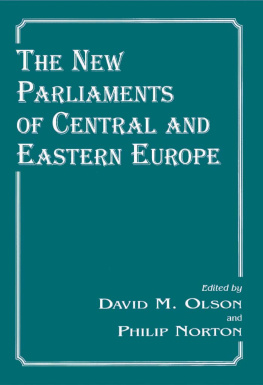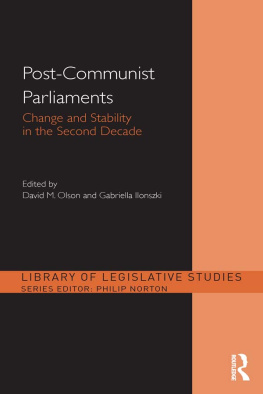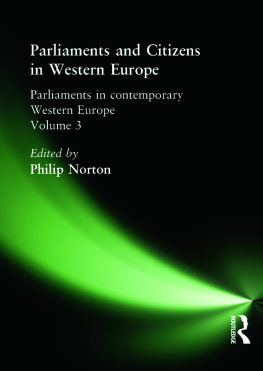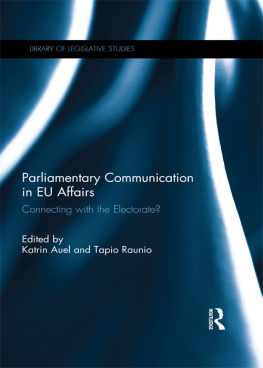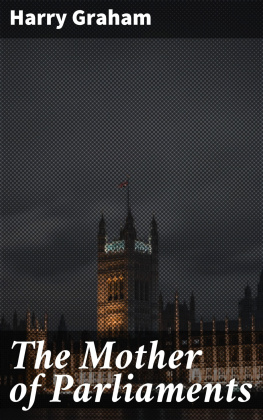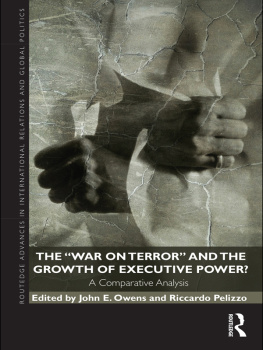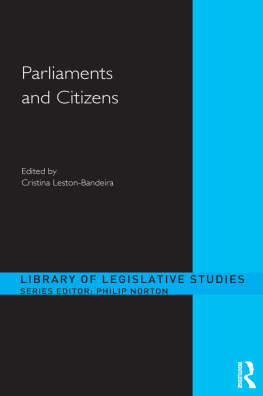First published in 1996 in Great Britain by
FRANK CASS AND COMPANY LIMITED
Crown House, 47 Chase Side, Southgate, London N14 5BP, England
and in the United States of America by
FRANK CASS
c/o International Specialized Book Services, Inc.
5824 N.E. Hassalo Street, Portland, Oregon 927213-3640
Copyright 1996 Frank Cass & Co. Ltd
Reprinted 2001
British Library Cataloguing in Publication Data
The new parliaments of Central and Eastern Europe
1. Legislative bodies Europe, Central 2. Legislative bodies
- Europe, Eastern
I. Olson, David M. II. Norton, Philip
328.30943
ISBN 0 7146 4715 2 (hardback)
ISBN 0 7146 4261 4 (paperback)
ISBN 978-1-135-21357-2 (ePub)
Library of Congress Cataloging-in-Publication Data
The new parliaments of Central and Eastern Europe / edited by David M. Olson and Philip Norton.
p. cm.
This group of studies first appeared in a Special issue of the Journal of legislative studies, vol. 2, no. 1 (Spring 1996) CIPs pub. info.
Includes bibliographical references and index.
ISBN 0-7146-4715-2 (hb). -- ISBN 0-7146-4261-4 (pb)
1. Legislative bodies-Europe, Eastern. 2. Legislative bodies-Former Soviet republics. 3. Europe, EasternPolitics and government1989- 4. Former Soviet republics-Politics and government. I. Olson, David M. II. Norton, Philip.
JN96.A71N49 1996 95-53926
306.2309491717-dc20 CIP
This group of studies first appeared in a Special Issue of The Journal of Legislative Studies, Vol.2, No. 1 (Spring 1996), [The New Parliaments of Central and Eastern Europe].
All rights reserved. No part of this publication may be reproduced, stored in a retrieval system, or transmitted in any form, or by any means, electronic, mechanical, photocopying, recording or otherwise without the prior permission of Frank Cass and Company Limited.
Printed & bound by Antony Rowe Ltd, Eastbourne
Legislatures are ubiquitous and have consequences for political systems. The focus of analysis has typically been the role of the legislature in affecting policy outcomes in an established polity. Opportunities for analysing the role of legislatures in regime transitions have been limited. The transition from Communist regimes to new democracies in central and eastern Europe provides a rich field for analysis. This paper provides the framework for analysis, identifying two key variables in constitution making the specific experiences of a nation and borrowing from foreign practice -and three sets of variables in determining legislative activity: the external environment, internal characteristics, and policy attributes.
Legislatures are remarkable institutions. They are pervasive. Relatively few countries are without one. Federal nations typically have several. They are a core feature of democratic states. They have also been a feature of many Communist and one-party states. Their consequences for their respective political systems have varied enormously,
Given their constitutional status as core state institutions, their number and, in some cases, their longevity the Icelandic Althingi and the British Parliament dating back several centuries it is not surprising that literature on legislatures is extensive. Yet the literature is notable for its gaps as much as for its quantity. We know a great deal about individual legislatures, most notably the US Congress, but relatively little about legislatures as a particular species of institution. The obstacles to comparative analysis have been several and substantial. Few attempts have been made to consider the role of legislatures in regime transition. What role do legislatures play in the change from one political system to another? Are they important actors, serving to shape a new constitution and give it life? Or are they peripheral and dependent, the product of forces upon which they then exert no reciprocal influence?
One reason for the limited attempt at answering such questions is limited resources. The field of comparative legislative study is not a crowded one and scholars are not necessarily in a position to study at close quarters some of the transitions that take place. Another reason is limited opportunity. Though the century has been littered with countries moving from one political system to another dictatorship to democracy, one-party state to multi-party state, democracy to military dictatorship there have been relatively few cases in recent history where several countries with one particular type of regime have moved over to another type at the same time. The basis for systematic comparative analysis has been limited.
Latin America has provided a rare case of regime changes occurring at once among many countries in a region, and has generated an important literature. In central and eastern Europe, the collapse of the Soviet regime has led to the emergence of new post-Communist regimes. For legislative scholars, events in Europe in recent years thus provide a rich field of study.
It is the events in central and eastern Europe that form the focus of this volume. The fall of Communism throughout central and eastern Europe created opportunities that seemed unimaginable less than ten years before. The old regimes collapsed. One disappeared with the reunification of Germany. The other newly liberated nations each had the opportunity to forge a new democratic constitution.
In analysing the period of transition, there are two common features. One is the time period. The newly emerging democratic nations were undergoing their transition at the same time. The other is the creation of a legislature. As in other countries, though going by different names for convenience, referred to here as parliaments legislatures were transformed in each country.
We thus have the basis for a systematic analysis of the role of parliaments in the transition from non-democratic to democratic regimes. That analysis is of countries that differ remarkably. The countries of the Soviet bloc were under the same yoke but beyond that often had little in common. Soviet domination did not so much transform the societies that
The type varies considerably. Some of the countries have some pre-Communist experience of democratic structures and practices; others have none. Some, notably Poland with the Roman Catholic Church, have a unifying social force; others have none. Some are ethnically homogeneous; others are not, displaying at times serious ethnic tensions. Some appear to have an entrepreneurial culture, or at least exhibit an entrepreneurial tendency; some appear to have a culture of dependency, which the Soviet years reinforced rather than erased. To refer to central and eastern Europe is to refer to a geographical entity and a collection of countries that endured the same domination for a part of the twentieth century, and are having to come to terms with the consequences of the end of that domination, but beyond that is a term with limited utility.
The shared experience of these countries in terms of Soviet hegemony provides us, then, with the focus of our enquiry but we proceed on the basis that they are very different in their social, economic and olitical needs and orientations. We would hypothesise therefore that parliaments in these countries will develop in different ways. The extent of differences, and similarities, will form the core of our enquiry.
The potential for different responses by legislatures is facilitated by the nature of the new environment in which they are created. The transition from Communist to post-Communist regimes has been a paradigmatic one. The nature of the change and the nature of Communist rule combine to create a situation in which parliaments operate in a relatively uncrowded political space.

